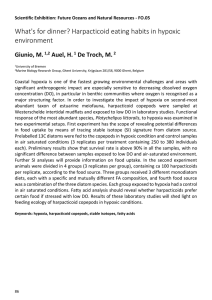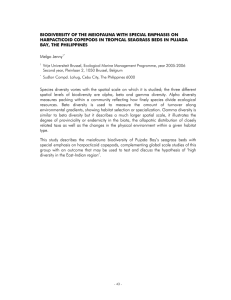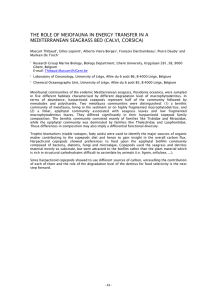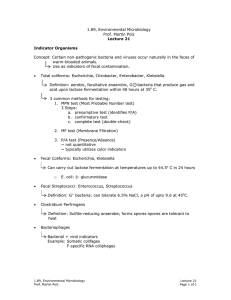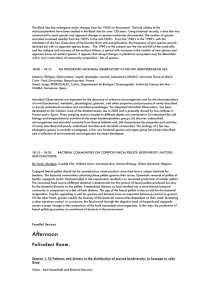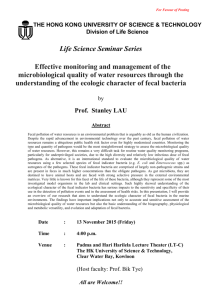Chapter General introduction 1
advertisement
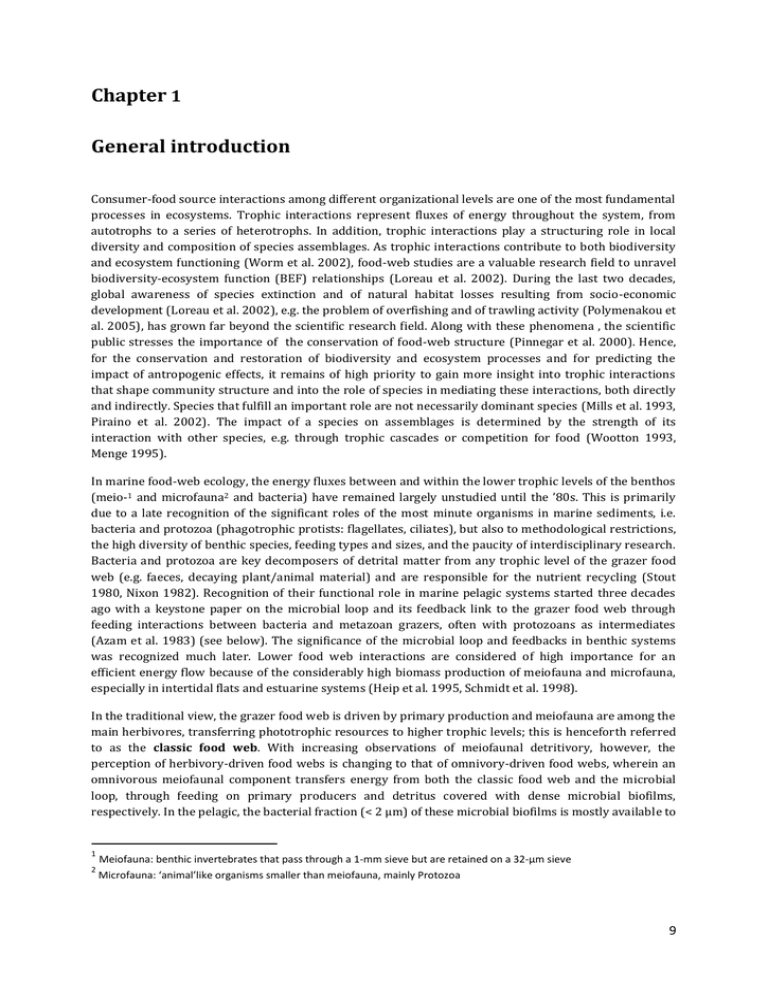
Chapter 1 General introduction Consumer-food source interactions among different organizational levels are one of the most fundamental processes in ecosystems. Trophic interactions represent fluxes of energy throughout the system, from autotrophs to a series of heterotrophs. In addition, trophic interactions play a structuring role in local diversity and composition of species assemblages. As trophic interactions contribute to both biodiversity and ecosystem functioning (Worm et al. 2002), food-web studies are a valuable research field to unravel biodiversity-ecosystem function (BEF) relationships (Loreau et al. 2002). During the last two decades, global awareness of species extinction and of natural habitat losses resulting from socio-economic development (Loreau et al. 2002), e.g. the problem of overfishing and of trawling activity (Polymenakou et al. 2005), has grown far beyond the scientific research field. Along with these phenomena , the scientific public stresses the importance of the conservation of food-web structure (Pinnegar et al. 2000). Hence, for the conservation and restoration of biodiversity and ecosystem processes and for predicting the impact of antropogenic effects, it remains of high priority to gain more insight into trophic interactions that shape community structure and into the role of species in mediating these interactions, both directly and indirectly. Species that fulfill an important role are not necessarily dominant species (Mills et al. 1993, Piraino et al. 2002). The impact of a species on assemblages is determined by the strength of its interaction with other species, e.g. through trophic cascades or competition for food (Wootton 1993, Menge 1995). In marine food-web ecology, the energy fluxes between and within the lower trophic levels of the benthos (meio-1 and microfauna2 and bacteria) have remained largely unstudied until the ’80s. This is primarily due to a late recognition of the significant roles of the most minute organisms in marine sediments, i.e. bacteria and protozoa (phagotrophic protists: flagellates, ciliates), but also to methodological restrictions, the high diversity of benthic species, feeding types and sizes, and the paucity of interdisciplinary research. Bacteria and protozoa are key decomposers of detrital matter from any trophic level of the grazer food web (e.g. faeces, decaying plant/animal material) and are responsible for the nutrient recycling (Stout 1980, Nixon 1982). Recognition of their functional role in marine pelagic systems started three decades ago with a keystone paper on the microbial loop and its feedback link to the grazer food web through feeding interactions between bacteria and metazoan grazers, often with protozoans as intermediates (Azam et al. 1983) (see below). The significance of the microbial loop and feedbacks in benthic systems was recognized much later. Lower food web interactions are considered of high importance for an efficient energy flow because of the considerably high biomass production of meiofauna and microfauna, especially in intertidal flats and estuarine systems (Heip et al. 1995, Schmidt et al. 1998). In the traditional view, the grazer food web is driven by primary production and meiofauna are among the main herbivores, transferring phototrophic resources to higher trophic levels; this is henceforth referred to as the classic food web. With increasing observations of meiofaunal detritivory, however, the perception of herbivory-driven food webs is changing to that of omnivory-driven food webs, wherein an omnivorous meiofaunal component transfers energy from both the classic food web and the microbial loop, through feeding on primary producers and detritus covered with dense microbial biofilms, respectively. In the pelagic, the bacterial fraction (< 2 µm) of these microbial biofilms is mostly available to 1 2 Meiofauna: benthic invertebrates that pass through a 1-mm sieve but are retained on a 32-µm sieve Microfauna: ‘animal’like organisms smaller than meiofauna, mainly Protozoa 9 CHAPTER 1 copepods (Gonzalez et al. 2004). However, there is still high uncertainty about the nutritional value of bacteria associated with detrital matter for benthic meiofauna. For nematodes, a close interaction with bacteria is apparent, with observations of bottom-up (e.g. Moens & Vincx 1997, Moens 1999, dos Santos et al. 2008) and top-down interactions (e.g. Moens et al. 2005b, Hubas et al. 2010). The first aim of this PhD thesis was to gain insight into the dietary importance of bacteria for harpacticoid copepods, which are often the second most abundant meiofaunal taxon in marine sediments, next to nematodes (Hicks & Coull 1983). In combination with the second objective, i.e. assessing the mechanism of microbial degradation of copepod fecal pellets, this thesis covered the link between the classic and the microbial food web in both directions (Fig. 1). The Paulina intertidal area, encompassing a salt marsh and tidal flat zone in the polyhaline reach of the Westerschelde Estuary (SW Netherlands), was used as study area. The area spanned a range of sediment types and other abiotic factors (hydrodynamics, tidal height, pore water content, physico-chemical gradients, shore vegetation etc.), providing several habitats with variable food availability and food quality, different harpacticoid assemblages and thus presumably differences in local food-web interactions. In this way, we attempted to obtain a broader view on the spatio-temporal context of trophic interactions between harpacticoid species and bacteria. Fig. 1. Trophic interactions between harpacticoid copepods and bacteria, indicating upward fluxes from the microbial food web to the classic (primary production-based) food web and downward fluxes of waste products from the traditional food web to the microbial food web. In the topics elucidated below concerning food webs and trophic interactions, we have concentrated on specific examples from benthic intertidal and shallow coastal systems. For the introduction on the microbial loop and copepod fecal pellets, however, the only available reference works stem from the planktonic environment. 10 INTRODUCTION BENTHIC FOOD WEBS AND LOWER FOOD-WEB INTERACTIONS Marine temperate intertidal sediments are highly productive ecosystems as a result of high primary production, high nutrient load and high inputs of allochtonous detritus. Intertidal flats receive allochtonous inputs from marine, riverine and terrestrial origin, and in salt marshes and nearby sediments, from exported salt marsh vegetation. Microphytobenthos (MPB) and mainly diatoms contribute predominantly to the total primary production (McIntyre 1969, Underwood & Kromkamp 1999) and form the basis of the classic food web where carbon and energy are transferred to herbivores such as non-pigmented microflagellates, ciliates, nematodes and harpacticoid copepods (Montagna et al. 1995, Epstein 1997), and these in turn to higher trophic levels such as macrofauna and larval and juvenile fish (Gee 1987) (Fig. 2). Fig. 2. Simplified conceptual model of the benthic microbial and classic marine food web in shallow-water marine sediments. Arrows indicate carbon flow. The shaded area represents the dissolved organic carbon (DOC) based microbial loop. Slightly modified from First (2008). In a partly separate detritus pathway, the detritus/DOC pool supplied by the herbivorous food web (dead MPB, animal carcasses and fecal matter) is a nutrient source for heterotrophic bacteria (Fig. 2.). A fraction of the benthic bacterial production is consumed by bacterivorous protists and nematodes and was estimated to vary largely, from < 1% to 528 % of bacterial production (Hondeveld et al. 1995, Epstein 1997). The latter studies clearly demonstrated that the removed fraction of bacterial production strongly relates to spatio-temporal dynamics in bacterial grazing rates and bacterial production, owing to e.g. sediment type and temperature conditions. They in turn are preyed upon by non-bacterivorous protists, harpacticoid copepods or macrofauna (Azam et al. 1983, Rieper 1985, Coull 1990, Reiss & Schmid-Araya 2011). Nevertheless, for example in Westerschelde intertidal sediments, the largest fraction of bacterial biomass does not flow back to the grazer food web (Herman et al. 2001) but is probably lost by viralinduced bacterial cell lysis (Danovaro et al. 2008). The detrital food chain also includes macro- and 11 CHAPTER 1 microdetritivores, terms referring to detritus-feeding macro- and meiofauna. However, for macrofauna which actually ingest detrital matter (Tenore 1977, Leduc & Probert 2009), the term ‘detritivore’ is more applicable than for the smaller meiofaunal organisms which may consume detritus-associated bacteria rather than the actual detrital matter itself. Bacteria and protists, the smallest-sized component of the marine biota (< 20 µm), are an integral part of the lower trophic levels of the classic and detrital food webs. In early conceptual models of pelagic food webs and carbon flows, these organisms were ignored, based on the assumption that primary production is transferred to higher trophic levels predominantly in the particle phase and not as DOM. As a consequence, bacterial populations were assumed to be too sparse and their activity too low to play a significant role in organic matter flow (Azam 1998). The microbial loop concept of Azam et al. (1983) introduced microbes into marine food-web ecology (Fig. 3). The microbial food web predominantly comprised heterotrophic DOM-consuming bacteria, involved in organic matter degradation and nutrient remineralisation, and bacterivorous flagellates and larger-sized ciliates. These organisms are unique in their ability to recuperate DOM originating from algae, sloppy feeding, virus-induced cell lysis, etc., thus reducing energy loss from the classic food chain. A smaller component of the microbial loop are the most minute autotrophic phytoplankton organisms and herbivorous flagellates (photosynthetic picoplankton) feeding on them. Later, the role of viruses, with abundances often exceeding those of bacteria (i.e. 10 10 per liter compared to 109 per liter in open waters), became incorporated into the concept (Azam 1998, Azam & Worden 2004) (Fig. 3). Viruses are particularly abundant in nutrient-rich waters and in sediment pore water rather than in overlaying waters. With bacteria being the main host of viruses, virus-induced bacterial mortality (10 - 50% of bacterial mortality) (Cochlan et al. 1993) forms an additional input of DOC which is recycled by other heterotrophic bacteria. Viruses are considered a sink as bacterial biomass is made unavailable for the grazer food chain and an increased bacterial respiration associated with this enlarged DOC pool implies a loss in efficiency of the microbial loop. Fig. 3. The ‘original’ microbial loop, as described in Azam et al. (1983) (solid arrows), and with later additions (dotted arrows). DOC: dissolved organic matter. From: Fenchel (2008) The transferable fraction of heterotrophic microbial biomass associated with the detritus pool is shunted in multiple ways to the classic food web: (1) from bacterivorous protozoa to protozoan grazers (e.g. 12 INTRODUCTION harpacticoid copepods, as mentioned before), and (2) through direct grazing on detritus-associated bacteria by microdetritivores. In addition, and of specific importance in the benthic system, heterotrophic microbes are living associated with fresh algae and consume algal-derived DOC and extracellular polymeric substances (EPS) (Grossart & Ploug 2001, van Oevelen et al. 2006b), which comprise ca. 40-70 % of algal productivity (Goto et al. 1999). Hence, the ‘classic’ meiofaunal microphytobenthos grazing and co-ingestion of bacteria is potentially an underestimated pathway of microbial energy transfer. Detailed benthic food-web schemes are scarce but one of the most detailed schemes integrating components of the classic, the detrital and the microbial pathway and reporting on the carbon flows among those components, is from Van Oevelen et al. (2006b) on the Molenplaat intertidal flat (Schelde estuary, Belgium-The Netherlands) (Fig. 4). This food web can be considered representative for the Paulina food web. In the food web of the Molenplaat, the trophic significance of bacterial carbon for the different benthic taxa was low and similar for macro- and meiobenthos, with < 1% contribution to the organisms’ carbon requirements (van Oevelen et al. 2006a). The macro- en meiobenthos depended mainly on phytodetritus and microphytobenthos (classic pathway), the microbenthos on detritus and DOC (detrital pathway), and bacterial biomass largely formed a sink. Other studies have confirmed the limited role of bacteria for meiofauna (Sundback et al. 1996, Moens & Vincx 1997) and macrofauna (Cammen 1980, Kemp 1987, Andresen & Kristensen 2002), the latter with an upper limit of 10% of the carbon requirements met by bacterial carbon consumption. Among meiobenthos taxa, some nematodes and ciliates showed higher bacterial carbon consumption than harpacticoid copepods and foraminiferans (Epstein & Shiaris 1992, van Oevelen et al. 2006a). Nevertheless, bacteria may deliver some trace elements, such as vitamins and the high bacterial ingestion rates compared to ingestion in case of indiscriminate feeding suggest selective uptake of bacteria by macro- and meiofauna (Lopez & Levinton 1987, van Oevelen et al. 2006a). In the Molenplaat and Paulina area, the microphytobenthos is of high importance to all heterotrophic levels, including bacteria, nematodes, foraminifera and macrofauna (Herman et al. 2000, Middelburg et al. 2000, Moodley et al. 2000). Furthermore, nematodes represent a second trophic level as predators (Gallucci et al. 2005, Moens et al. 2005a). Harpacticoid copepods were not included in any of these studies and their trophic niche is yet unexplored. 13 CHAPTER 1 Fig. 4. The intertidal food web. Carbon inputs are primary production by microphytobenthos, macrobenthic suspension feeding on phytoplankton, phytoplankton and suspended particulate matter deposition. DOC is produced through EPS excretion by microphytobenthos and bacteria and consumed by bacteria and microbenthos. Detritus is consumed and produced (death and faeces production) by all heterotrophic compartments. Microphytobenthos and bacteria are grazed by nematodes, meiobenthos and macrobenthos, nematodes are grazed by predatory nematodes and macrobenthos, and meiobenthosis grazed by macrobenthos. Carbon outflows are respiration (diamond head arrows), macrobenthic export (e.g. consumption by fish or birds) and bacterial burial. Only non-zero flows are pictured. The arrows with indicated values are not scaled, because their dominance would otherwise mask the thickness differences among other arrows. The lower panel shows nematodes, meiobenthos and macrobenthos on a different scale to better indicate the flow structure. Abbreviations – mpb: microphytobenthos, bac: bacteria, mic: microbenthos, mac: macrobenthos, doc: dissolved organic matter, det: detritus, phy: phytoplankton, spm: suspended particulate matter, dic: dissolved organic carbon and exp: export from the system. From: Van Oevelen et al. (2006) HARPACTICOID COPEPODS: ECOLOGY AND SPATIO-TEMPORAL DISTRIBUTION Harpacticoid copepods are small crustaceans within the size range of 0.2 to 2.5 mm and belong to the Order Harpacticoida of the subclass Copepoda (systematic position see addendum II). Harpacticoida comprise 52 families and well over 3000 species, and are essentially free-living, benthic copepods (Boxshall & Halsey 2004). They are cosmopolites in the marine environment, occurring from marine to brackish water, from the intertidal zone to the deep sea (review by Hicks & Coull 1983, Van Gaever et al. 2009). Harpacticoid copepods are the second most abundant meiofaunal taxon in marine sediments, 14 INTRODUCTION second to nematodes. Maximum densities in intertidal sediments are 10 to 100 ind. per cm 2 (Boxshall & Halsey 2004). Their body morphology is highly diverse and characteristic for their life mode, i.e. interstitial, burrowing or epibenthic. Harpacticoid copepods may form an important link in benthic food webs by channeling energy to higher trophic levels. In addition, harpacticoids, as part of the meiofauna, may facilitate biomineralisation of organic matter, enhance nutrient regeneration and may be ecosystem engineers, shaping the habitat in such a way that resources become more easily available for other organisms (Coull 1999, and references herein). Harpacticoid copepods are rarely the dominant meiofaunal group in marine soft sediments (dominance of nematodes). Their occasional dominance in coarse sediments as well as in muddy salt marsh sediments (Hicks and Coull, 1983 and references therein) and during certain periods of the year, indicates that their distribution patterns are very habitat-specific and determined by a set of interacting biotic and abiotic variables and by their (re)colonization success (Giere 2009). Small-scale spatial zonation patterns of harpacticoid copepods (from cm to ha) are regulated by physicochemical gradients and other abiotic factors (temperature and salinity, grain size, redox potential discontinuity layer, oxygen, pore water content) (Findlay 1981). The distribution of harpacticoids is also determined by the patchiness of microbial food sources, as shown from laboratory experiments (Gray 1968, Lee et al. 1977, Ravenel & Thistle 1981, Decho & Castenholz 1986) as well as spatial autocorrelation studies (Findlay 1981, Pinckney & Sandulli 1990, Blanchard 1991, Sandulli & Pinckney 1999). In turn, microalgal patchiness tends to be higher in siltier relative to sandy sediments, pointing towards a close link between food source distribution and sediment type (Sandulli & Pinckney 1999). The few available studies on temporal fluctuations suggest that harpacticoid species distribution may be regulated by temperature, food supply, predation pressure and trophic competition with other meiofaunal groups. Possible examples of competition are the inverse relationship between the harpacticoid Tisbe sp. and nematodes, and between Amphiascus limicola and Foraminifera in a mud flat (Hicks and Coull, 1983). Trophic competition among harpacticoid species has not been demonstrated directly, but indirect or correlative observations and biochemical content of copepods suggest resource partitioning (Pace & Carman 1996, Guisande et al. 2002, De Troch et al. 2005). Vanden Berghe and Bergmans (1981) suggested that the differential exploitation of photoautotrophic (herbivore) and bacterial food sources (bacterivore) among some co-occuring Tisbe sibling species can drive coexistence. By means of water-borne cues, harpacticoid copepods can locate food patches at distances of many body lengths (Seifried & Dürbaum 2000, Fechter et al. 2004). Whether trophic niche separation reduces resource competition and contributes to the co-existence of harpacticoid species is still unclear. POTENTIAL FOOD SOURCES AND POSITION OF HARPACTICOID COPEPODS IN THE BENTHIC FOOD WEB Meiofauna may play a significant trophic role in benthic energetics (Pinckney et al. 2003) and are involved in biomineralisation, nutrient regeneration andecosystem engeneering. Some of these ecosystem functions relate to the use of food sources and feeding rates of harpacticoid copepods. Harpacticoida are able to consume a wide range of natural food sources e.g. microalgae, cyanobacteria, flagellates, ciliates, mucoid substances, fungi, yeasts, bacteria as well as artificial food sources, e.g. fish flakes (Hicks and Coull 1983 and references herein). The natural food sources that will be discussed in this thesis are presented in fig. 5. These copepod-food source interactions were mainly concluded from laboratory feeding studies and indirect observations, using field distribution patterns, gut analyses, etc. Currently, direct evidence of food source assimilation from the field is obtained from tracing molecular dietary markers such as stable isotopes and fatty acids (see further). 15 CHAPTER 1 Harpacticoid copepods in intertidal and shallow coastal sediments are primarily considered grazers on microphytobenthos (MPB) (herbivorous), predominantly diatoms (Buffan-Dubau et al. 1996) (fig. 5), and as consumers of detritus with its associated microbiota (detritivorous) (Danovaro 1996) . A high reliance of meiofauna on diatoms is generally expected owing to the constant availability of diatoms in shallowwater ecosystems (Gall & Blanchard 1995) and to their high nutritional value because of their high content of essential amino acids and fatty acids (Brown et al. 1997), compared to the temporal fluxes and low nutrient quality of Spartina sp. (cordgrass) and other vascular plant detritus in salt marshes or adjacent sediments. Moreover, harpacticoid copepods are able to discriminate between diatom species, different diatom sizes or different diatom growth phases (Lee et al. 1977, Azovsky et al. 2005, De Troch et al. 2006, De Troch et al. 2012b). Due to such a highly selective feeding, harpacticoid copepods may (downor up-) regulate MPB diversity without changing overall MPB stock biomass (Azovsky et al. 2005). Detritivorous meiofaunal organisms, feeding on detrital particles and associated bacterial epibionts, have generally been thought to derive nutrients from the bacterial component (Giere 2009), unlike in real detritivores such as the polychaete Capitella capitata, which, depending on detritus quality, can derive a major portion of nitrogen from the detrital substrate itself (Tenore 1981, Findlay & Tenore 1982). There is still a strong uncertainty about dietary contributions of non-algal food sources to harpacticoid diets. Observations of flagellate and ciliate predation or other carnivorous feeding by harpacticoid copepods are relatively scant, e.g. predation on ciliates (Rieper 1985, Reiss & Schmid-Araya 2011), on their own offspring (Dahms & Qian 2006) and on nematodes (Lehman & Reid 1992), etc. In contrast, detritivory and bacterivory among harpacticoid copepods have often been suggested, but little concrete evidence exists. On the other hand, indirect trophic reliance of estuarine intertidal nematodes on detrital carbon through bacterial feeding has been documented for a number of species (e.g. Moens & Vincx 1997, Moens et al. 1999a, Hamels et al. 2001, De Mesel et al. 2004) Fig. 5. Schematic overview of the different microbial and non-microbial food sources which will be dealt with in this thesis. Blue arrows represent reported interactions in literature. Red arrows are indicative for the reverse or top-down copepod-bacteria link. Arrow thickness is an indication of the significance/strength of the interaction. Dotted lines are indirect copepod-bacteria interactions. 16 INTRODUCTION Bacterivory Bacterial densities in estuarine sediments are often in the order of 10 9 cells ml-1 porewater, which is two orders of magnitude higher than in the pelagic, and are fairly constant (Schmidt et al. 1998). However, their fate is under debate. Heterotrophic protists are the main bacterivores, but bacterial carbon transfer to higher trophic levels is often rather limited. Nevertheless, among meiofaunal taxa, bacterivorous nematodes are well recognized (Moens & Vincx 1997, Moens 1999), e.g. in salt marshes, where they may play a role in the decomposition processes of Spartina sp. detritus through their top-down effect on the bacterial assemblages (De Mesel et al. 2003, De Mesel et al. 2004). However, no straightforward statements on ‘bacterivory by harpacticoid copepods’ have been made. Yet, several laboratory studies have proven (1) the importance of associated bacterial biofilms for harpacticoid substrate selection (Gray 1968, Hicks 1977), (2) harpacticoid preferential feeding on bacteria while a more nutritional food source is available, (3) the ability of harpacticoid copepods to selectively choose certain bacterial groups (Rieper 1978, Vandenberghe & Bergmans 1981, Rieper 1982, Carman & Thistle 1985, Montagna et al. 1995, Dahms et al. 2007), and (4) assimilation of bacterial carbon by harpacticoid copepods (Brown 1977, Decho & Castenholz 1986, Montagna & Bauer 1988). Observations are, however, too scattered and limited to reveal patterns in the occurrence and prominence of harpacticoid bacterivory, in relation to harpacticoid taxonomy, habitat or bacterial groups. Furthermore, a trophic dependence on bacteria is thought to be specific for some mucus-producing copepods, e.g. the encysting copepods Diarthrodes nobilis (Hicks & Grahame 1979) and Heteropsyllus nunni (Coull & Grant 1981), where the mucus provides an easily degradable substrate for bacteria and may function for microbial gardening, as also suggested for nematodes and a few macrofaunal species (Riemann & Schrage 1987, Riemann & Helmke 2002). The few indications of bacterial carbon assimilation by harpacticoid copepods are related to grazing on autotrophic food sources such as diatoms, resulting in a combined uptake and assimilation of diatom and bacterial carbon (Decho & Fleeger 1988) (fig. 5), or in an elevated or even exclusive assimilation of bacterial carbon relative to diatom carbon (Brown 1977, Decho & Castenholz 1986). Also, the copepod Paramphiascella fulvofasciata responded to the removal of its fecal pellets by an increased production of fresh fecal pellets. In combination with other observations, this suggests that this harpacticoid copepod grazes upon its fecal pellets and more specifically on the bacteria associated with the pellets (De Troch et al. 2009) (Fig. 1). Since bacteria (and detrital matter) are comparatively poor-quality food sources, typically lacking polyunsaturated fatty acids (Chen et al. 2012) which are essential to harpacticoid copepods, the nutritional contribution of bacteria to consumers is thought to be restricted to some trace elements, such as vitamins. In contrast, De Troch et al. (2012a) demonstrated that copepods assimilate bacterial fatty acids and may bioconvert these to essential poly-unsaturated fatty acids which are lacking in bacteria. Copepod gut absorption is suggested to be evolutionarily adapted to the absorption of these essential nutrients (Mayzaud et al. 1998, Thor et al., 2008). APPLIED MOLECULAR TECHNIQUES TO STUDY HARPACTICOID FEEDING ECOLOGY Investigation of meiofaunal trophic interactions has been greatly advanced by analyzing the molecular composition of consumer and food sources (Leduc et al. 2009). Stable isotopes (13C/12C, 15N/14N) have been proven to be powerful tools to assign consumer diet in the field and species trophic position in the food web, or to quantify diet consumption in isotope enrichment experiments (review Boschker & Middelburg 2002, Boecklen et al. 2011). With each assimilation step in the food web, there is a stepwise enrichment (‘fractionation’) of the organism in the heavier isotope (13C, 15N), owing to a metabolic loss of the lighter isotope (12C, 14N) during food assimilation and growth. Fractionation of carbon isotopes between consumer and resource is ca. 0.5 ‰, and thus carbon isotopic signature of the consumer closely resembles that of its diet, and fractionation of nitrogen is ca. 3.4 ‰ (Post 2002, McCutchan et al. 2003). 17 CHAPTER 1 Hence, dual stable isotope signatures of field-caught copepods reveal information on their energy sources and their trophic position. A minimal of 5 µg C and N is required for analysis and this corresponds to around twenty and sixty harpacticoid copepods, respectively. Consequently, stable isotope ratios of harpacticoid copepods have mostly been reported at the community level and especially nitrogen isotopic signatures of copepods are rare. Given that harpacticoid copepod diets may be complex (multiple food sources) and variable in time, their ‘mixed’ natural isotopic signatures may still give a false indication of food source utilization. Harpacticoid feeding ecology has been extensively studied under simplified feeding conditions in laboratory microcosms. In laboratory feeding experiments, harpacticoid copepods are fed with 13C-enriched food sources, such as diatoms and bacteria which have been 13C-labelled during laboratory culturing with 13Cbicarbonate and 13C-glucose, respectively (e.g. De Troch et al. 2008, Ingels et al. 2010). Isotope-enriched food sources allow precise tracing of selective food uptake and this dietary information from both experimental and natural isotopic signatures can be implemented in linear mixing models to determine the relative importance of resources and quantify energy transfer in marine benthic food webs (e.g. van Oevelen et al. 2006a, 2006b). Diet can also be inferred from the consumers’ fatty acid composition and the concentrations of individual fatty acids. Fatty acids are essential for the functioning of cell membranes (phospholipids) and for energy storage (triacylglycerols, wax esters). Certain individual fatty acids are characteristic for a group of organisms and when transferred to the consumer without further modification, these are good dietary tracers or biomarkers (review Kelly & Scheibling 2012). Biomarker fatty acids applied in marine studies originate for instance from microphytobenthos (20:5ω3, 22:6ω3) and bacteria (15:0, 17:0, 15:1, 17:1, 18:1ω7) (Kelly & Scheibling 2012, and references therein). In comparison to stable isotopes, the fatty acid approach potentially has a higher trophic resolution as a mixed diet may be revealed by the presence of different biomarkers in the consumers’ fatty acid pool. Analogous to the fractionation-issue in stable isotope approaches, the trophic transfer of fatty acids is not absolute since many incorporated foodrelated fatty acids are modified by the consumer. Optimization of the fatty acid approach for meiofaunal ecology research is still ongoing, for example, by the search for more diagnostic fatty acids and by attempts to unravel the pathways of fatty acid bioconversion. Consequently, stable isotopes and fatty acids data can complement each other, circumventing the limitations of the individual approaches bu even this dual approach may not allow to differentiate feeding on diverse microphytobenthos taxa (Leduc et al. 2009). RELEVANCE OF COPEPODS FOR THE MICROBIAL LOOP Apart from their potential trophic interaction with bacteria, copepods have feedback links to the microbial loop. Firstly, copepods contribute to the organic and inorganic inputs of the microbial loop through the production of dissolved organic matter (DOM) and particulate organic matter (POM) in the form of fecal pellets (fig. 5), and the excretion of inorganic nutrients (NH 4+, urea) (Møller et al. 2003, 2011, Saba et al. 2011). Secondly, through fecal pellet production, copepods continuously deliver new physical substrates for bacterial attachment and subsequent cell division. Hence, copepod feeding activity enhances bacterial production and biomass (Eppley 1981, Roman et al. 1988, Peduzzi & Herndl 1992, Vargas et al. 2007), and bacterial activity (Richardot et al. 2001). The copepod body itself, especially the mouth and anal region, is also a favored substrate for bacterial attachment (Carman & Dobbs 1997, Maran et al. 2007). DOM In the pelagic, the release of extracellular material by primary producers may provide about 50 % of carbon requirements of heterotrophic bacteria (Baines & Pace 1991), suggesting that all heterotrophic 18 INTRODUCTION bacteria partly depend on allochtonous carbon from the detrital pathway. Copepods lose about 50-70 % of grazed carbon, primarily in the form of DOM rather than POM (Møller & Nielsen 2001). DOM production is mainly due to sloppy feeding and to fecal pellet leaching. Rates of DOM production relate to copepod grazing activity and assimilation efficiency, both of which are in turn influenced by the size ratio copepodfood source and by food availability (Møller & Nielsen 2001, Møller 2007) POM POM production of planktonic copepods (Calanoida) mainly comprises fecal pellets enclosed by a peritrophic membrane (Fig. 6). Planktonic copepods channel about one third of ingested carbon to fecal pellets (Fig. 7). In addition, dispersed amorphous small particles lacking a membrane are released and these may even reach up to 66% of total fecal POM (Olesen et al. 2005). It is unknown whether harpacticoid copepods also excrete such large fraction of amorphous matter in addition to the larger-sized fecal pellets. Fig. 6. Harpacticoid fecal pellets resulting from diatom feeding in the laboratory: a) light microscopic image of fecal pellets from the harpacticoid Paramphiascella fulvofasciata, enclosed by a peritrophic membrane (arrows) (De Troch et al. 2009), and b) SEM image of fecal pellets from Platychelipus littoralis. Fecal pellet decomposition – trophic upgrading Through efficient degradation of sinking fecal pellets by heterotrophic bacteria and zooplankton, ‘lost’ energy is shunted back to the grazer food web. As such, copepod fecal pellets contribute significantly to the energy flow and nutrient cycling in marine ecosystems. Studies on the degradation and fate of benthic fecal pellets are not available, but a similar process of fecal pellet recycling could be expected, whereby fecal pellets are reworked by bacteria and potentially through fecal pellet-grazing harpacticoid copepods. Rapid degradation of planktonic fecal pellets is concluded from the low fecal pellet abundances retrieved from sediment traps in coastal environments. Over 60% of fecal pellet production appears to be recycled in spite of the fast sinking rates of copepod fecal pellets compared to phytoplankton (Olesen et al. 2005). No studies on degradation rates for benthic fecal pellets exist. Firstly, DOM-leaching soon after fecal pellet egestion stimulates bacterial fecal pellet colonization and thus the rate of bacterial conversion of fecal POM to DOM. Planktonic copepod fecal pellets are bacterial hot spots in terms of activity and abundance (Jacobsen & Azam 1984, Tang et al. 2001, Thor et al. 2003), and a similar situation may be observed for benthic fecal pellets in view of their close contact with fecal pellets in the sediment (De Troch et al. 2010). Fecal pellet degradation rates can be highly variable, depending on a range of factors such as temperature, pellet density (Hansen et al. 1996), surface:volume ratios (Hansen and Bech, 1996), etc. Also, the precise mechanism of bacterial degradation is still uncertain. The 19 CHAPTER 1 contribution of external versus internal bacteria to fecal pellet degradation remains unknown and the functional groups of active bacteria (anaerobic or facultative aerobic bacteria) are as yet unidentified. Fig 7.. Carbon fluxes of grazing copepods (Calanus spp.) during spring bloom in Disko Bay, western Greenland, showing the percentage of carbon removed from suspension (RFS) that ends up in the carbon DOC and POC pools. From: Møller et al., 2003. Secondly, fecal pellets may be consumed by marine detritivorous Metazoa. Filter-feeding planktonic copepods capture fecal pellets and re-process them through coprorhexy (fragmentation of fecal matter) and potentially coprophagy (ingestion of fecal matter) (Poulsen & Kiørboe 2005, Iversen & Poulsen 2007), thus facilitating fecal pellet retention in the water column (review by Turner 2002). Fecal pellet matter is generally considered a poor-quality food source and there are two explanations for the interaction between zooplankton and their fecal pellets. Fecal pellet reworking by zooplankton is suggested to be a passive mechanism, resulting from unintentional capturing of these particles during filter-feeding. Alternatively, fecal pellets are of some trophic value and are actively consumed by zooplankton. Fecal pellets can contain high proportions of undigested, protein-rich matter. For example, during excessive food availability (diatom blooms) when food ingestion rates are high and gut transit time is short, food digestion is less efficient and viable diatom cells are packed within the fecal pellet. On the other hand, fecal pellets may be biochemically or trophically upgraded (gaining in trophic value) by bacteria whereby the extensive bacterial biomass associated with the fecal pellet and not the fecal matter itself serves as a source of proteins. During bacterial degradation of the fecal pellet, heterotrophic bacteria incorporate nitrogen from the water and use energy from nitrogen-poor organic compounds from the fecal pellet to biosynthesize new proteins (Johannes & Satomi 1966). De Troch et al. (2009) illustrated that also in the benthic food web, a similar interaction among copepods and fecal pellets exists, with bacterial decomposers as potential intermediates. The harpacticoid copepod Paramphiascella fulvofasciata responded to the removal of its fecal pellets by increasing its fecal pellet production in terms of number of pellets (but not net production) resulting in more but smaller fecal pellets (De Troch et al. 2009). This points towards the need for fecal pellets in its vicinity and a potential trophic role of fecal matter. Copepods are among the group of detritivores that re-use fecal pellets and in particular the associated 20 INTRODUCTION bacterial biofilm, albeit evidence for benthic species is still scarce (Koski et al. 2005, De Troch et al. 2009, Møller et al. 2011). Fecal pellets can be a favourable food source during periods of low diatom availability (Johannes & Satomi 1966, Morales 1987). Yet, unequivocal evidence of the trophic role of fecal pellets and its heterotrophic bacteria is lacking. RESEARCH OBJECTIVES AND THESIS OUTLINE The overall aim of this work was to gain insight into food source utilization by harpacticoid copepods from a heterogeneous estuarine intertidal ecosystem, focusing on species-specific responses to varying food availability, food quality and physical sediment characteristics and with particular interest in the trophic importance of bacteria for harpacticoid copepods. Hereby, this thesis dealt with the upwards link (energy flow) between the microbial loop and the basal grazers of the intertidal benthic classic food web. For this purpose, both field data (chapter 2 and 3) of harpacticoid species with regard to their spatio-temporal distribution and dietary pattern were collected and experimental feeding studies (chapter 4 and 5) with individual species were carried out. The studied harpacticoid species originated from the Paulina intertidal area. In the second part, the reverse or top-down link is studied, which involves the role of copepod fecal pellets as a substratum for bacteria and the bacterial degradation process of copepod fecal pellets, hereby focusing on the contribution of internal and external fecal pellet bacteria during early degradation (chapter 6). Bacterial cell abundances, biomass and the (state of) peritrophic membrane were also visualized by Atomic Force Microscopy and Laser Scanning Confocal Microscopy (AFM-LSCM), an innovative high-resolution imaging tool which offers new prospects for studying microbial degradation of copepod fecal pellets (chapter 7). All chapters from this thesis, apart from the general introduction and discussion, and addendum I represent stand-alone research papers, which are published or in press (chapter 4, 5, 6; addendum I), submitted (chapter 7) or in preparation for submission (chapter 2, 3). Consequently, there is some overlap in the material-and-methods sections and in the description of the study area. Here, in the general introduction (chapter 1), the scientific setting of this PhD thesis was outlined. It is important to note that the order of the following chapters does not necessarily reflect the order in which these research aspects were performed, let alone completed. A logical first step when addressing the importance of (variability in) food availability for, and resource partitioning within, harpacticoid copepod assemblages, is to perform a field study into both spatial and temporal heterogeneity in resource availability and copepod abundance and assemblage structure in a field situation, taking into account not only variability in resources but also in other potential, mainly abiotic, drivers of assemblage structure and abundance. Hence, chapter 2 focused on the heterogeneity and structural characteristics of intertidal harpacticoid assemblages (density, diversity and composition) from five habitats in the Paulina intertidal area differing in sediment characteristics, tidal height, presence of vegetation, etc. These were sampled during 4 sampling campaigns. The environmental factors, comprising both abiotic factors and food-source related factors regulating the spatio-temporal variation in harpacticoid assemblage composition, were determined. For the most abundant species, a more in-depth analysis of the most influential factors for species distribution was performed, adding relevant information to their autoecology. Chapter 3, then, used natural (mainly) carbon isotopic signatures as well as fatty acid biomarker patterns and abundances to infer field resource use of, and resource partitioning among, the most abundant copepod taxa from chapter 2, covering exactly the same spatial and temporal variability as in chapter 2 and therefore allowing maximal linkage between both chapters. This approach allowed us to get a general idea of the in situ trophic importance of bacteria, MPB and detritus as food for copepods and provided insights into (1) the overall trophic diversity of harpacticoid species in the study area, comprising different habitats, and (2) trophic diversity within habitat types, as well as into (3) spatio-temporal 21 CHAPTER 1 dietary variability of some of the most abundant species. It also allowed a first assessment of the extent of bacterivory in harpacticoid copepods from this tidal flat-salt marsh system. In chapters 4 and 5, we used microcosm experiments to evaluate some aspects of harpacticoid bacterivory using 13C-labelled bacteria as food. Two to four co-occuring harpacticoid species originating from the Paulina area were selected for these experiments. Experiments were performed while the sampling campaign for chapters 2 and 3 was still ongoing and we did not yet have adequate information on the in situ feeding strategy. Our selection of species, therefore, aimed to incorporate representatives of different putative feeding types/habits (Hicks & Coull 1983). Since feeding behavior of harpacticoid copepods is often linked to morphology and/or general behavior, e.g. epi- vs endobenthic life style, motility, tubebuilding, species to be used in the laboratory experiments were selected based on morphological and behavioral characteristics and habitat preference (epi/endobenthic) and on field abundances. In the feeding experiment of chapter 4, species-specific bacterial uptake and the mechanism of uptake were examined by means of a 13C-enriched bacterial inoculum. Bacterial uptake might be selective considering the highly selective feeding behavior of harpacticoid copepods towards other food sources such as diatom cells. Additionally, harpacticoid copepods generally co-ingest bacteria during diatom grazing, but it is unclear whether bacterial uptake can be an independent feeding strategy, i.e. independent from feeding on another food source and independent of the presence of a grazing substratum in general. We specifically addressed the following questions: can copepods target bacteria in absence of another food source? Or in other words, can harpacticoid copepods consume bacteria associated with a purely physical grazing substratum without nutritional value (i.e. sediment grains). We also assessed whether harpacticoid copepods are physically able of consuming bacteria in absence of such a grazing substratum. In addition, copepod fatty acid content and polyunsaturated fatty acid content (PUFA) were screened to assess copepods’ general condition after 4 days of incubation with a bacterial food source, and to identify the potential nutritional contribution of feeding on bacteria in terms of fatty acids (next to the bulk carbon transfer assessed by the 13C assimilation). In a subsequent food selection experiment (chapter 5), the ability of harpacticoid copepods to select between two bacterial species was tested, using three bacterial strains offered as 1x1 combinations. Selected bacterial strains were chosen based on their differences in fatty acid and protein composition and thus potential nutritional value, a characteristic that might drive harpacticoid selective feeding and/or assimilation. The remaining two regular chapters (chapters 6 and 7) focused on the role of bacteria as colonizers and decomposers of copepod fecal pellets. In particular, in chapter 6 we attempted to evaluate the relative importance of internal versus external active fecal pellet bacteria in the early degradation process (up to 60 h incubation in natural seawater) through genetic and metabolic community profiling of active bacterial communities on fecal pellets of different age. We hypothesized that active external bacteria, which are expected to rapidly colonize the fecal pellet, would dominate over internal active bacteria and therefore dominate the decomposition process. The presence of internal and external bacteria, as well as the peritrophic membrane surrounding the fecal pellet were visualized using the high-resolution imaging technique Atomic Force Microscopy - Laser Scanning Confocal Microscopy (AFM-LSCM) (chapter 7) by means of an optimized protocol. AFM generally allows studying bacterial cell size, cell shape and cell-cell interactions. Here it was applied (1) to visualize the ultra-structure and measure the thickness of the peritrophic membrane and (2) to locate and quantify bacterial presence (cell size measurements) both inside and outside the fecal pellet. The main conclusions of this work are summarized and discussed in chapter 8. This work has been supported by a Ph.D. grant from the agency for Innovation by science and Technology (IWT) (data from October 1th 2008 onwards). During the year prior to attaining IWT financing, an experimental study was performed with focus on harpacticoid microalgal feeding and the suitability of a preserved food source (addendum I). Diatom assimilation was lower on the preserved food source compared to freshly-cultured living diatom cells. The reduced palatability of preserved diatom cells could be related to reduced chemical signaling (absence of diatom EPS) interfering with copepod grazing 22 INTRODUCTION activity and diatom ingestion. On the other hand, assimilation of preserved diatoms could be hampered by a reduced (active) bacterial film attached to the diatom cells, which in turn has affected copepod gut flora and fecal pellet bacteria. Addenda II to VI comprise supplementary material to the chapters 2 to 6. 23
